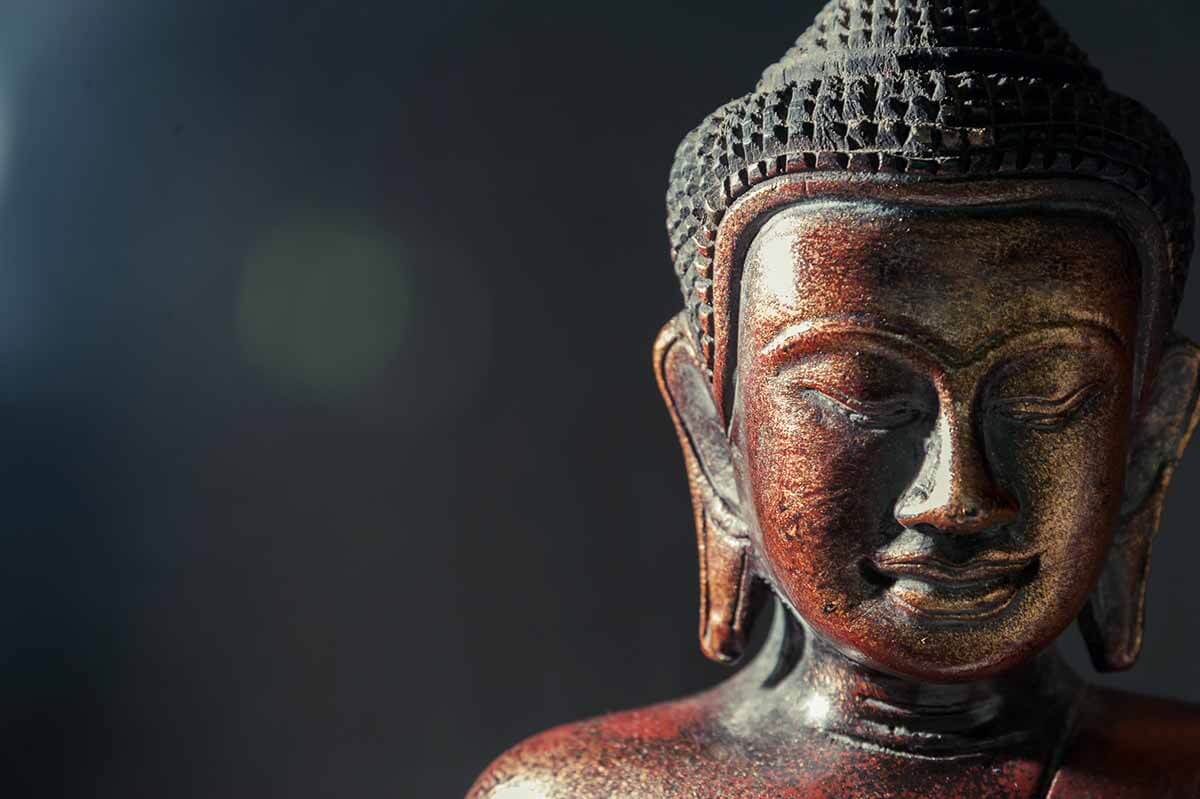Meditation is becoming increasingly popular in contemporary Western society for its many benefits, such as reducing stress and facilitating greater concentration. You may be interested in learning how to practice meditation and gain these benefits. Or you may already be a practitioner of meditation, but you are hoping to expand your knowledge. In either case, knowing the history of meditation, its origins, and the tradition behind it is a great asset to learning more about how to do it.
The concept of meditation goes back several thousand years and is thought to originate in southern China and northern India; however, it exists in some form across nearly every major world religion and has also come under the auspices of scientific study for Westerners.
So how and where did meditation take its roots? Let’s begin with the likely birthplace of its earliest practices.
Article Contents
What Are the Origins of Meditation?
The word “meditation” originated in the 12th century and comes from the Latin word meditatum, which means “to ponder.” However, the earliest evidence of the practice of meditation comes from the Indus River valley of what is now southern China and northern India.
Archeologists uncovered wall art on rocks and within caves that depict people sitting in what could be described today as meditative postures with their eyes partially closed. These depictions are believed to date as early as 5000 BCE during the hunter-gatherer phase of human existence!
The first written records of meditation are believed to have originated around 1500 BCE from Vedic texts, an ancient Indo-Aryan religion of Central Asia that is the precursor of Hinduism. These documents speak of the concept of dhyana, a term later used in both Buddhism and Hinduism to refer to contemplation and meditation. Specifically, the Vedic texts speak of the various methods found in that time of training the mind.
It is especially important to note that these texts were not the origins of these practices; rather, it is likely that they are the first known written documents codifying oral tradition and storytelling of meditation passed down throughout many generations before.
Where Did the Practice of Meditation Begin?
The formal development of meditation systems began in the 6th century BCE. China and India were the epicenters of this growth.
Three key figures were instrumental in creating paths of enlightenment, for which meditation became a key step in this journey. While these figures certainly did not invent the practice or even terms of meditation, their teaching paved the way for the rapid growth and expansion of meditation across the known world.
What Religion Does Meditation Come from?
There is no one religion from which meditation comes, but the following systems of belief (and their founders) were instrumental for the eventual proliferation of meditation.
Buddhism
The most notable teacher of meditation—and often the person erroneously credited as having invented it—was Siddhartha Gautama, more popularly known as the Buddha. The Buddha was a nobleman who, as a young adult, made a conscious choice to reject his upbringing in favor of seeking the true path of enlightenment as an itinerant beggar.
The essence of this path, as he taught, was to understand and become more aware of dukkha, a term essentially meaning “the suffering and unworthy pursuits of this life,” and ultimately to escape from dukkha in a state of being called nirvana. Nirvana’s literal translation is “to be blown out” like a candle, a state of being free from the endless cycle of rebirth and clinging to unworthy things.
There are two important aspects of the Buddha’s teaching on meditation that shaped this pursuit of the Noble Truths and ultimately nirvana:
- One is bhavana, which refers to the regular requirements of meditation for mental development. Meditation is essential to learning and practicing essential virtues such as love, justice, and truth while letting go of the obsession of “fleeing” things such as wealth and power.
- The other quality is dhyana, which is roughly translated to “mental calmness.” This refers to meditation’s ability to allow a person to live in the present, not suppressing emotions but letting them be acknowledged and then letting them go instead of acting them out.
Taoism
Another important figure coming up in the 6th century BCE was Lao Tzu, a semi-legendary figure who is noted as the founder of Taoism. His name means “old teacher” or “old master.”
Contemporary scholars disagree as to whether Lao Tzu was one person or a combination of teachers. Regardless, the famous text attributed to him, the Tao Te Ching, spoke of how humanity may live in harmony with the Tao, the “Way” or life force that energizes all that exists.
In Taoism, meditation became especially focused on becoming one with the Tao. This was accomplished through practices that emphasized mindfulness and visualization. For the latter, the sounds of nature (e.g., a rushing stream), a mantra, or an image were meant to stimulate the body and mind’s ability to be swept into the force of the Tao and to a state of perfect and sublime consciousness.
Confucianism
Also dating from the 6th century BCE, Confucius was a Chinese teacher and philosopher whose main interest was understanding that the “secular life is also sacred.” Unlike Buddhism and Hinduism, which sought to help people escape from this fleeting and fragile life, Confucius emphasized the need for perfect social harmony, particularly within the family. This was accomplished through deepening one’s understanding of justice and morality by personal growth through study and meditation.
The meditative technique in Confucianism is called Jing Zuo, which simply means “sitting quietly.” This form was not unique to Confucianism, but its purpose was not to stop a person’s rational thoughts but rather to enhance and encourage them. Fulfillment of the self was the goal, not emptying of the self. In early Confucianism, Jing Zuo was used more for healing and medical purposes than for spiritual fulfillment.
With the revitalization of Neo-Confucianism in the 9th century CE, this technique acquired a richer sense of orienting a person’s entire being to a pursuit of harmony with self and others.
What Religions Have Meditation as a Practice?
All major world religions have some form of meditation. The following examples are religions widely followed that have their own unique expression of meditation.
Zen Buddhism
While technically a form of Buddhism, Zen is also heavily influenced by the Taoist tradition. Its founder was Dosho, a Buddhist monk who visited China in 653 CE and apprenticed under the notable Buddhist master Hsuan Tsang.
Upon returning to Japan, Dosho began teaching his students the art of Zazen, a form of sitting meditation heavily focused upon the aspect of dhyana, or the emptying of the mind. For Dosho, dhyana meant not simply calmness but allowing the mind to be swept up into true consciousness.
He became master over a group of monks and quickly raised new masters who then taught this unique style of meditation to more students. By the 8th century CE, the expression of Buddhism known as Zen began to grow and flourish all over Japan.
Hinduism
Hinduism shares many similarities to Buddhism, particularly in the path to achieve release from the wheel of eternal rebirth (known as moksha for Hindus). One of the six orthodox schools of Hinduism whose practices have greatly influenced modern meditation is the Yoga School. Yoga’s primary texts are from the Yoga Sutras of Patanjali, dating from approximately the 4th century BCE.
The emphasis on meditation in yoga is that, unlike other schools of Hinduism, which emphasize knowledge as the key to achieve moksha, one’s body, mind, and spirit must be trained through the proper technique and practice to realize moksha. The physical movements of modern-day yoga are directly derived from these ancient techniques.
However, it is essential to understand that there is a deeply spiritual component to the ancient Yoga practices. Western yoga has emphasized the technique’s physical and mental aspects while downplaying or eliminating the spiritual emphasis on centeredness.
Monotheistic Faiths
All of the three major monotheistic faiths also emphasize meditation in some form:
- Islam – Mainstream Islam encourages meditation through a practice called Tafakkur, which is essentially a quiet reflection upon God’s creation and the purpose of the individual within it. A deeper (and not universally accepted) mystical approach is called Sufism. This school emphasizes techniques of breathing and mantras to strengthen the believer’s faith and ability to submit to God and carry out God’s work in the world.
- Judaism – Mysticism spans across much of the Jewish tradition, with notable schools being Kabbalah (meaning “reception”) and Hasidism. While expressed with different techniques, the general goal of all Jewish mysticism is to help mortal believers comprehend the fullness of the omnipotent Creator. Often passages of scripture, certain sacred numbers such as four and seven, or the name of God are images or mantras that help direct meditation.
- Christianity – Icons, rosaries, and reflective scripture reading (called lectio divina) have been used by Christians to draw believers to a deeper relationship and connection with God. The 20th-century Roman Catholic monk Thomas Merton is credited with re-introducing contemplation into Christian devotional life. One example of this is through centering prayer, a form of silent meditation in which practitioners have a keyword or image that, similar to Buddhist dhyana, helps to calm the mind—with the notable difference of opening the believer to God’s presence.
How Many Kinds of Meditation Are There?
The proliferation of meditation into the West in the 20th century has created numerous types rooted in one or more major world religions—with at least four fundamental types. Some of these forms bear a close resemblance to their ancient practice; others synthesize varying traditions that seek to achieve specific goals. All of them provide practitioners with a greater sense of themselves and the world around them.
While not comprehensive, the following list describes some of the fundamental types of meditation:
Mindfulness
Mindfulness is the most popular form of meditation in the West and the one most closely connected with the Buddhist meditative practice of dhyana. In this form, the practitioner focuses on breathing or an image, being mindful (but not judgmental!) of the thoughts passing through their head. The goal is not to manipulate one thoughts but to be aware of them and their surroundings.
Movement Meditation
There are varying forms of meditation that focus on the body’s movement. Some examples of this are yoga and Tai Chi. In all cases, the purpose of the movement is to facilitate a deeper connection between the body and mind. As implied in the name, movement is an active kind of meditation often reckoned as a physical exercise by many Western practitioners.
Transcendental Meditation
This form was introduced to the West in the 1950s by Maharishi Mahesh Yogi, an Indian teacher who started the practice in India and later began traveling abroad to share it.
The purpose of transcendental meditation (TM) is to bring the practitioner to a heightened state of mental awareness. This is done through structured meditation practice, twice a day for 15-20 minutes, with a repetitive mantra to help guide the sessions. While TM formed separately, some forms of contemplative Christian meditation, such as centering prayer, are very similar in structure to TM.
Metta
This word means “positive energy” in Pali, a northern Indian language where this form originated. It is a form of Buddhist meditation focused on building kindness in oneself to others, the creation, and oneself. The mantras here are usually words of kindness spoken toward others. It has become a popular form in the West to build positive energy and counter feelings of anger and resentment.
Final Thoughts
Meditation’s richness is found both in its long history and also in the diversity of its expressions. You should definitely look into meditation as a student. It has proven to be a sound method for connecting people to a deeper knowledge of themselves, the world around them, and their spiritual truth. Whether you are an active practitioner or a beginner, continue to explore the richness of this tradition and discover the form that helps you live a happier and healthier life!




